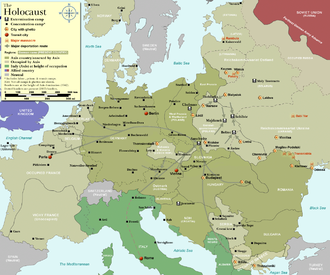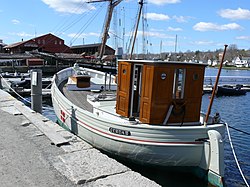Before World War II
In 1933, Hitler and the Jewish League agreed to the Haavara Agreement in which, over time, German Jews and their finances could and would settle in Mandatory Palestine. Furthermore, the Havaara Mark was used instead of the Deutschmark, because of its lower interest rates, and it was seen as more favourable. By the end of the 30‘s, over 60000 German Jews had emigrated to Palestine. [1] Following this, they discouraged emigration by restricting the amount of money Jews could take from German banks and imposed high emigrations taxes. The German government forbade emigration from the Greater Germanic Reich after October 1941. The German Jews who remained, about 163000 in Germany and less than 57000 from annexed Austria, were mostly elderly who were murdered in ghettos or taken to Nazi concentration camps, where most were murdered. [2] Jews were able to leave Vichy France until the fall of 1942. [3]
Although Jews could initially leave Nazi Germany with ease, it was difficult to find countries that would take them, particularly after the initial wave of immigrants in Europe, Britain, and the United States had been accepted. [2] One of the reasons that emigration was so difficult was that it began during the Great Depression. [1]
During World War II
...we all wanted to get rid of our Jews but that the difficulties lay in the fact that no country wished to receive them.
Following the Anschluss, the annexation of Austria to Germany in 1938, and forced emigration deepened the refugee crisis, the Évian Conference was held in France to explore options for countries to emigrate to, but the key outcome of the conference was that it proved that forced emigration would not solve the problem. [4] Another was a concern that there might be pro-Nazi spies among the refugees. [3]
It was also difficult to get out of Europe. After the war started, there were few ships that left European ports. Lisbon was a neutral port, however, from which refugees could still travel. [3]
At the time that Hitler came to power in Germany in 1933, [5] there were about 523000 German Jews (<1 percent of the population) in the country. [2] Subject to threats and persecution, Jews began to emigrate from that point until the start of World War II. [2] [5] In Austria, more than 50% of the Jews had left the country by May 1939, following Adolf Eichmann's program to force Jews to emigrate that began in the spring of 1938. Franz Mayer, a Jewish leader, said of Eichmann's system: "You put in a Jew at one end, with property, a shop, a bank account, and legal rights. He passed through the building and came out at the other end without property, without privileges, without rights, with nothing except a passport and order to leave the country within a fortnight; otherwise, he would find himself inside a concentration camp." [4] By the end of 1939, there were more than 117,000 Jews who left Austria and more than 300,000 who left Germany. Most of them were trained in a particular field or college-educated. Generally, they were young in age. [2] [5]
Many of the 100000 people who found refuge in neighbouring European countries, like the Netherlands, Belgium, and France, were captured and murdered by the Nazis, after May 1940, when they invaded western Europe. [2] [1] As the Nazi regime occupied Czechoslovakia, beginning in 1938, and invaded Poland in 1939, there were more Jewish refugees. [6]





